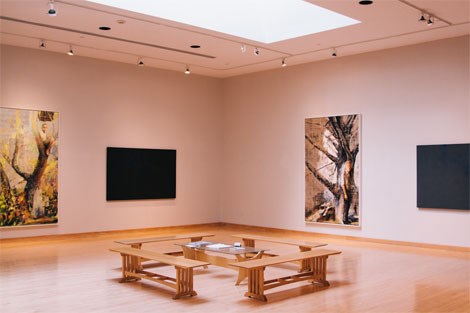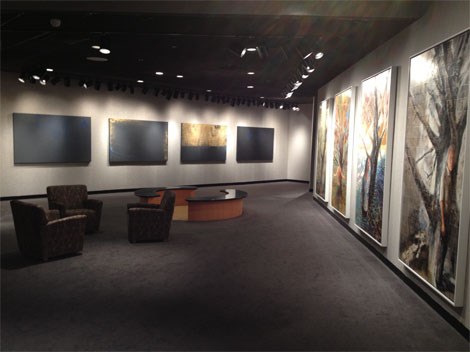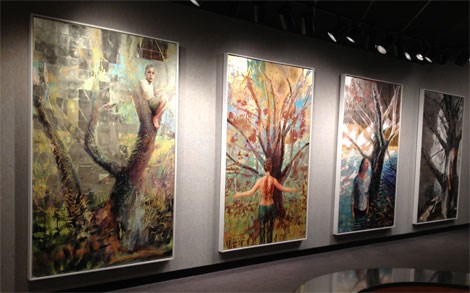Matthew J. Milliner and Brett Foster
"The Dark Dove with the Flickering Tongue"
Seeing T. S. Eliot again, anew.For much of this year, the multimedia project QU4RTETS has drawn lovers of art, music, and literature to galleries and lecture halls at Baylor University, Duke Divinity School, Yale Divinity School, Gordon College, and now Wheaton College. The project, inspired by T. S. Eliot's great work of religious poetry, Four Quartets, consists of collaborations by painters Bruce Herman and Makoto Fujimura, who contribute four paintings apiece, and an original musical composition by Christopher Theofanidis, along with responding essays in an exhibit catalogue by the likes of Jeremy Begbie and others (including one of the present authors). Both authors had the opportunity to make a few remarks on Four Quartets the poem and QU4RTETS the show at its opening reception at Gordon recently, and had the following impressions to share. The exhibit is now on display at Wheaton College, and can be visited daily there through September 22.
An event with artist Bruce Herman will take place at 3:30pm on Saturday, September 21st at the Billy Graham Center Museum.

Matt: Considering the current (overblown? perpetual?) "crisis" in the humanities, it is disorienting to note that Eliot's lecture on the frontiers of criticism filled a University of Minnesota football stadium in 1956. Nobel laureate T. S. Eliot was the "Pope of Russell Square," who was even once driven through the streets of Rome to droves of students crying Viva Eliot! As one of his biographers put it, he was simply "Great Tom." Eliot now, of course, is deeply unfashionable, and the precipitous nosedive of his literary fortunes is something of an injustice. Anthony Julius' notorious booklength indictment, T. S. Eliot, Anti-Semitism and Literary Form, has been thoroughly upended (by Jewel Spears Brooker, Ronald Schuchard, and John Xiros Cooper, among others). They point out that the anti-Semitism of Mark Twain, Charles Dickens, Virginia Woolf, and D.H. Lawrence is far more explicit and consistent than the four brief passages from Eliot's pre-conversion poetry that are repeatedly cited by the prosecution. Eliot is on record insisting, "I am not an anti-Semite and never have been …. [I]n the eyes of the Church, to be anti-Semitic is a sin." Somehow, though, alongside the fabricated notion that everyone thought the world was flat before Columbus, the myth of Eliot's anti-Semitism endures. One way, then, to explain the excitement surrounding the QU4RTETS project is relief that Eliot is again gaining the hearing he deserves. In fact, these works exemplify exactly the kind of art Anthony Julius himself called for in a different context: "anti-transgressive art, one committed to the construction of criteria rather than the breaking of taboos."
But having reflected upon the poem in relation to these paintings for the past year—including close contact in the last months with them at Wheaton College—I've come to realize that a vigorous defense of Eliot, let alone an attempt to restore him to his literary throne, would be out of spirit with his poetry, nor is this what the QU4RTETS project is about. Eliot's ascendency is not something he would have jealously defended. Rather, he warned of fascination with "eminent men of letters" for their own sake, which is to say, he warned against exactly the kind of universal adulation that he once enjoyed. "I no longer strive to strive towards such things," the converted poet tells his readers in "Ash Wednesday." Eliot, all too aware of his faults, complained that the "fools' approval stings, and honour stains." Or as "East Coker" puts it, "Do not let me hear / Of the wisdom of old men, but rather of their folly." Perhaps the collapse of Eliot adulation is the very kind of purging that Eliot tries to guide his readers through in his greatest poem. So, thank you, Anthony Julius, I guess.
Standing in front of the Quartets-inspired paintings in person for the first time at Gordon College, looking into the faces that Bruce Herman has painted and the bright darkness conveyed by Makoto Fujimura, it struck me that these painters have learned the same lessons of purgation. Mako's attachment to Four Quartets came out of 9/11, not to mention the destruction of many of his works in Hurricane Sandy just as QU4RTETS began its tour. Likewise, Bruce's lifelong grappling with the poem (he has large swaths of it memorized) is connected to a freak fire where nearly all of his paintings and the home that he built were incinerated. If Eliot's poetry and these paintings mean to "teach us to care and not to care," it therefore seems appropriate to examine Eliot as we did not in a football stadium, but in exile of sorts—quietly tucked away at beautiful Gordon College and now Wheaton, paying homage to a poet who has been stripped of his literary epaulettes.

Brett: Matt, I see the benefits of this "revaluation from a remove" that you describe, but I would also venture that neither Eliot nor his poetry are at risk of suffering a permanent exile. Certainly not among readers interested in texts of religious literature. And there is the built-in element of high modernist difficulty that ensures for his writing a lasting academic attention. (Eliot's contemporary James Joyce was very conscious about how modernist difficulty could help to bring about literary critical canonization.) There is a long tradition of scholarly scrutiny of Eliot's sources for what we might call the historical roots of Four Quartets. I have an abiding interest in this poet's being deeply influenced by Renaissance writers. Word choices such as "axle-tree" in "Burnt Norton" and this phrasing in "East Coker"—"Holding each other by the hand or arm / which betokeneth concorde"—contribute to the poem's elevated voice of the striver and meditative speaker. Those presences derive very much from Eliot's own literary critical work on Elizabethan or Jacobean authors such as George Chapman or Thomas Middleton. A new monograph on this topic has just appeared by Steven Matthews, T. S. Eliot and Early Modern Literature, and lovers of Eliot as a religious poet may also find of interest a special "forum" section in last spring's issue of Religion & Literature, on "New Directions in Religion and Literature Criticism of T. S. Eliot."
If these connections represent a more venerable historical criticism, increasingly Eliot scholars are studying anew how the poet's own biographical and historical contexts shaped his writing. We may be poised to read Four Quartets more deeply—if also more counterintuitively—as we increase our awareness of Eliot's London context in the early 1940s, during which he completed the poem's last sections. We begin to notice strikingly local details in a poem where we have been taught not to expect them—a paired example of "Asia" and "Edgeware Road" that is probably meant as a more tongue-in-cheek moment than we would typically permit in this most serious of poems, and the commuter's simile of an "underground train" that stops "too long between stations." Eliot is famous for demanding as a critic the presumption of the impersonal artistic personality in the writings of any strong poet. His model author channels tradition and is masterfully detached. Yet he could also acknowledge that the author himself is hardly a poem's controller: "the meaning of a poem may be something larger than its author's conscious purpose, and something remote from its origins," Eliot wrote in "The Music of Poetry" in 1942—the same year he was working on "Little Gidding."
The point I made in my talk at Gordon was that meaning may reside sometimes in something smaller and more localized, in the setting and the circumstances that inform an author's conscious purpose, whatsoever it be and however conscious he or she is of it. Maybe this sense of the local and the circumstantial helps to explain why Eliot spoke of "Little Gidding" as a "patriotic poem."
But you couldn't be more right, Matt, about the context of purgation. Eliot's London during the time he was completing Four Quartets was of course under siege as the Battle of Britain raged, and that fact by itself should keep us from reading the poem too serenely. If it is a grand meditation, it is one arrived at with great concentration, as bombs were regularly exploding and destroying large parts of the city. Eliot, as is well known, worked as an air warden during this time. (I have always cherished the thought of one of the 20th century's greatest poets preparing for his post by putting out practice fires in Kensington Gardens.) He carried out firewatch duty two nights a week, an experience that surfaces in "Little Gidding": "In the uncertain hour before the morning / Near the ending of interminable night / At the recurrent end o the unending / After the dark dove with the flickering tongue / Had passed below the horizon of its homing." We do the poem an injustice if we approach it as readers largely oblivious to the historical crucible in which Eliot, somehow, created this masterpiece of composure.
Lara Fiegel's recent study of London's literary culture during this time, The Love-Charm of Bombs: Restless Lives of the Second World War, suggests how bold Eliot truly was in the Dantean setting of "Little Gidding," with its patrols and encounters on war-torn London's ruined, fiery streets. Other authors such as Graham Greene and Rose Macaulay wrote journalistic accounts of the destruction, but they were often censored by English authorities as "too vivid." The second and fourth sections of "Little Gidding," then, must have seemed more striking than we can easily imagine for the poem's first readers in 1943.
So, while Eliot's great poem aspires to the eternal, it is in fact a poem that becomes all the more powerful when read as a wartime work of art, and one whose four-part structure (beginning with the titles of each section) is identified in topographical terms. This gives the lie somewhat, or should, to prominent American poet Louise Glück's statement in an essay several years ago that Eliot was the "least materialistic" of American poets—a judgment which, in her terms, is deeply pejorative. For Eliot, she observed, the Real is that which is permanent, "under which system earth does not qualify." Reassessment is now at hand, especially after a few decades of what Glück herself calls the "animosity or pity" shown to Eliot by most poetry critics. New editions of Eliot's writings are inviting readers' fresh looks, as are wonderful homages such as Qu4rtets, whose landscapes and portraits and presences have given me fresh, receptive eyes and ears for Eliot's poem. So much for "least materialistic." In these materials is our renewal as readers of Eliot.
This is why it felt like good fortune to be able to visit the exhibit during its stint at Gordon, on Boston's North Shore, for that place, more than anywhere else, seems like "home" for such an exhibit. I say this because Gordon has been for a long time the home institution of Bruce Herman, who also oversees the Barrington Center for the Arts that displayed the paintings in its gorgeous gallery space. And of course this landscape north of Boston was alive in Eliot's veins, too, and appears in explicit ways within Four Quartets. This may come as a surprise to readers who identify Eliot's great poem of the 1940s as primarily mystical in nature, concerned above all with where time and eternity intersect.
Matt: Indeed, it was difficult to escape the material context of this poem as we smelled Cape Ann sea salt, saw the burial mound of a beached whale, and heard the absurdly loud, crackling rhythm of the ocean lapping against millions of Massachusetts beach stones: the poetic raw material of Eliot's New England. Painters got in on this game as well. Touring Cape Ann, we learned how Mark Rothko and other New York School luminaries would sneak up to Rockport to paint the same haunting seascape, cheating—so to speak—on Clement Greenberg (the New York art critic who only permitted abstraction). We ventured to a point where we could actually see the Dry Salvages that lent their name to the third quartet. Eliot's alchemy turned rocks sticking out of the ocean into a metaphor for human travail.
There was an urban aspect to our exploration as well. Touring Eliot's Gloucester was a reminder of the Anglo-Catholic sensibilities so expertly mined in Barry Spurr's magnificent book, "Anglo-Catholic in Religion": T. S. Eliot and Christianity. Henry Adams famously lamented the Virgin's absence in Protestant North America, but the Virgin still presides over Gloucester, that "Lady, whose shrine stands on the promontory." Factory fishing in international waters has replaced more modest vessels, and menacing white windmills dominate Gloucester's once charming skyline—but Eliot's ship-bearing statue of Mary above Our Lady of Good Voyage Catholic church is still there.
After a romp through Eliot's Harvard, we took our own good voyage back, and had every reason to slip into the very un-material, false serenity that you (Brett) rightly pointed out tends to afflict Eliot studies. After all, all the difficulties that gave rise to this poem and these paintings—the London bombing, September 11th, or a Massachusetts housefire—were safely distant (subjects to be reflected upon, not experienced). But on the news the very next afternoon came word of the Boston Marathon bombings in the same streets we'd been in just hours ago. Three killed and 264 injured (including 14 amputations).
Brett: We are now in a season where we all, sadly, have a better, more fearful comprehension of Eliot's own time of violence, one (it goes without saying but perhaps needs to be said) on a much larger, sustained scale.
Matt: The best art may come from suffering, but how awful when the conditions for its creation are met.
Matthew J. Milliner is assistant professor of art history at Wheaton College. Brett Foster is associate professor of English at Wheaton College.

Copyright © 2013 Books & Culture. Click for reprint information.








Displaying 0–0 of 0 comments.
Displaying 0–0 of 0 comments.
*